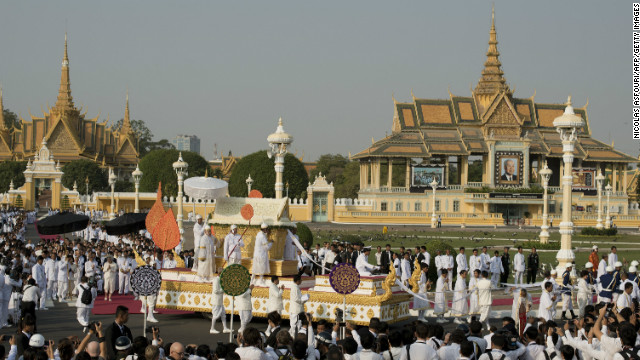(CNN) -- The ear-splitting crack of 101 rounds of
artillery will mark the final moment before late Cambodian King-Father
Norodom Sihanouk is cremated Monday in a specially built crematorium
outside the Royal Palace.
Sihanouk's son and
successor King Norodom Sihamoni and Queen-Mother Norodom Monineath
Sihanouk were set to light the funeral flame at 6 p.m local time (6 a.m.
ET), almost four months after the king's death last October at the age
of 90.
The somber event comes on
the fourth day of an elaborate seven day Royal Funeral Ceremony, which
started on Friday when the late king's body was carried on a winding
route through the capital Phonm Penh to the open square of Veal Preah
Merhu.
"Everybody had on a pin, a
brooch with a black and white ribbon and photograph of the king. People
were holding photos of the king in their hands. A lot of people were
crying, holding their hands in the worshiping position. (I was) very
touched, very moved," said Joyce Clark, vice president of programs at
the Friends of Khmer Culture from Phonm Penh.
On Monday, throngs of
people wearing white, the color of mourning in Cambodia, some with their
heads shaved, continued to queue for their chance to file past the
crematorium.
Many were weeping and
stopped to kneel, their palms pressed together and heads bowed in a
sampeah, a sign of respect. Attendants ushered them on to make way for
yet more mourners as the hours passed until the king's cremation.
Foreign leaders and
dignitaries from 16 countries were expected to attend the Royal
Cremation Ceremony, including the prime ministers of France, Vietnam and
Thailand. Also present will be more than 400 prisoners who were
pardoned as a gesture to mark the king's passing.
Sihanouk died while in Beijing on October 15, 2012 of natural causes, according to Cambodia's official AKP news agency. His body was flown home to the Royal Palace two days later where it had been lying in state before the weekend process.
Sihanouk reigned over
Cambodia for more than 60 years before he abdicated in 2004 due to poor
health, according to the king's official website.
A panel elected Sihamoni
as the new king. Cambodia's National Assembly then decided to give
Sihanouk the title of King Father, allowing him the same privileges he
has as the reigning monarch, according to his website.
Sihanouk saw Cambodia go
from French rule to independence, then to the brutal Khmer Rouge regime
and the guerrilla war that followed its toppling. He then watched his
country develop into the constitutional monarchy it is today.
He came from a royal
lineage, but it was France that placed Sihanouk on the throne in 1941,
according to the foreign ministry of Australia, which has played a key
role in Cambodia's transition toward peace.
The king dissolved the
nation's parliament in 1953, which helped bring about Cambodia's
independence. Two years later, he abdicated the throne to his father but
remained active as Cambodia's prime minister. In 1960, he became the
South Asian nation's head of state following his father's death.
In the 1960s, amid a
region simmering with conflicts such as the Vietnam War, Cambodia soon
became home to a number of North Vietnamese training camps. That
prompted U.S. air strikes on those camps in 1969.
The following year,
U.S.-backed Gen. Lon Nol declared a coup d'etat while the king was on an
official visit to the Soviet Union and abolished the monarchy.
Sihanouk aligned with the Khmer Rouge, a growing ultra-Maoist group which sought to transform Cambodia into an agrarian utopia.
The king, forced into exile in China, led the resistance movement, while the Khmer Rouge gradually gained strength.
When the group, led by
Pol Pot, won control of Cambodia in 1975, Sihanouk returned as head of
state. But by the following year, he was placed under house arrest.
From 1975 to 1979, the
Khmer Rouge led a bloody period of mass killings, public executions and
torture centers. While no one knows for certain how many people were
killed by the regime, experts estimate 1.7 million fatalities -- or at least a quarter of Cambodia's population -- died from executions, diseases, starvation and overwork
Sihanouk himself lost
five children and 14 grandchildren at the hands of the Khmer Rouge. He
was confined to the royal palace until Pol Pot was overthrown three
years later. He was away from Cambodia from 1979 to 1991.
The king subsequently
became president of the new republic, but it wasn't until 1993 -- when
Cambodia held its first parliamentary elections -- that the king's
powers were restored and Cambodia became a constitutional monarchy.
Elizabeth Becker, the
author of "When the War Was Over: Cambodia and the Khmer Rouge
Revolution," told CNN after the king abdicated in 2004 that Sihanouk was
"larger than life" and brought both good and bad to his country.
He tried to bring
Cambodia into the modern world and protect it from its neighbors, but he
brought about divisions in the process, she said.
"He threw his prestige
and politics behind the Khmer Rouge when they started the rebellion and
it was his name that helped convince a lot of peasants to go along with
the Khmer Rouge," Becker told CNN.
"Then later, after the
Vietnamese invasion, he continued to help the Khmer Rouge at the United
Nations with political prestige, so his is a very checkered legacy."


No comments:
Post a Comment